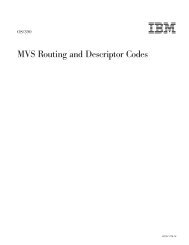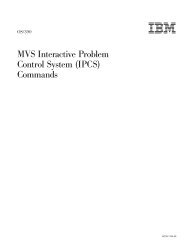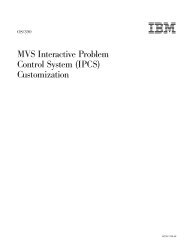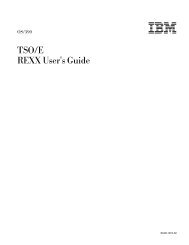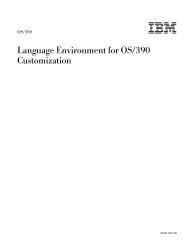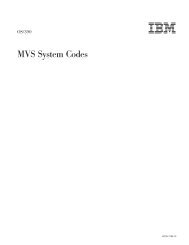OS/390 MVS IPCS User's Guid
OS/390 MVS IPCS User's Guid
OS/390 MVS IPCS User's Guid
Create successful ePaper yourself
Turn your PDF publications into a flip-book with our unique Google optimized e-Paper software.
<strong>IPCS</strong> Dialog Requirement<br />
The <strong>IPCS</strong> Dialog requires an interactive environment where TSO/E line mode<br />
messages are shown as they are written, not buffered. It is supported when<br />
run under supported levels of the following products:<br />
v <strong>MVS</strong>/System Product or <strong>OS</strong>/<strong>390</strong> <strong>MVS</strong><br />
v TSO/E or <strong>OS</strong>/<strong>390</strong> TSO/E<br />
v ISPF or <strong>OS</strong>/<strong>390</strong> ISPF<br />
To process a source in the <strong>IPCS</strong> dialog, specify the data set as the source on the<br />
<strong>IPCS</strong> default panel, in a SETDEF subcommand, or in a parameter on a<br />
subcommand. If the source is active storage, specify the MAIN parameter.<br />
Each <strong>IPCS</strong> panel has its own local defaults, including the source. The dialog<br />
facilities, subcommands, and command procedures used on the panel use the<br />
same source as the panel. Another panel, with its subcommands and command<br />
procedures, can use a different set of local defaults, including a different source.<br />
This arrangement allows you to view several, related dumps in parallel, which is<br />
helpful in diagnosing problems on different systems in a sysplex. Commands<br />
entered from a window run on the dump being viewed in the window.<br />
<strong>IPCS</strong> Batch Mode<br />
You can submit batch jobs that access <strong>IPCS</strong> to perform dump analysis against a<br />
specific dump.<br />
Saving Dump Analysis Results<br />
As you examine a dump of a software failure, <strong>IPCS</strong> accumulates information about<br />
the dump. <strong>IPCS</strong> uses the information it gathers each time you process the dump.<br />
<strong>IPCS</strong> saves the results of dump analysis.<br />
User Dump Directory<br />
The majority of the information generated by dump analysis is stored in the user<br />
dump directory, which is a data set allocated to the ddname <strong>IPCS</strong>DDIR. The user<br />
dump directory contains information, called a source description, used by <strong>IPCS</strong> to<br />
process dumps, traces, and other sources efficiently.<br />
The source descriptions resemble a notebook that <strong>IPCS</strong> uses as it processes a<br />
source; <strong>IPCS</strong> writes notes about the dump, such as its symbols, the location of<br />
control blocks, and session defaults. Later, when <strong>IPCS</strong> needs some information<br />
from its notes to format a dump, <strong>IPCS</strong> obtains it from the source description for the<br />
dump.<br />
Sysplex Dump Directory<br />
In a sysplex, the systems can share a sysplex dump directory. This directory<br />
contains source descriptions like the ones in a user dump directory, but the source<br />
descriptions are for sources from all the systems that share the sysplex dump<br />
directory.<br />
When any system that shares the sysplex dump directory produces an SVC dump,<br />
the system automatically writes a source description for the dump in the sysplex<br />
dump directory. If you want to analyze the dump, you can copy the source<br />
description from the sysplex dump directory to your user dump directory.<br />
Chapter 1. Introduction to <strong>IPCS</strong> 7



